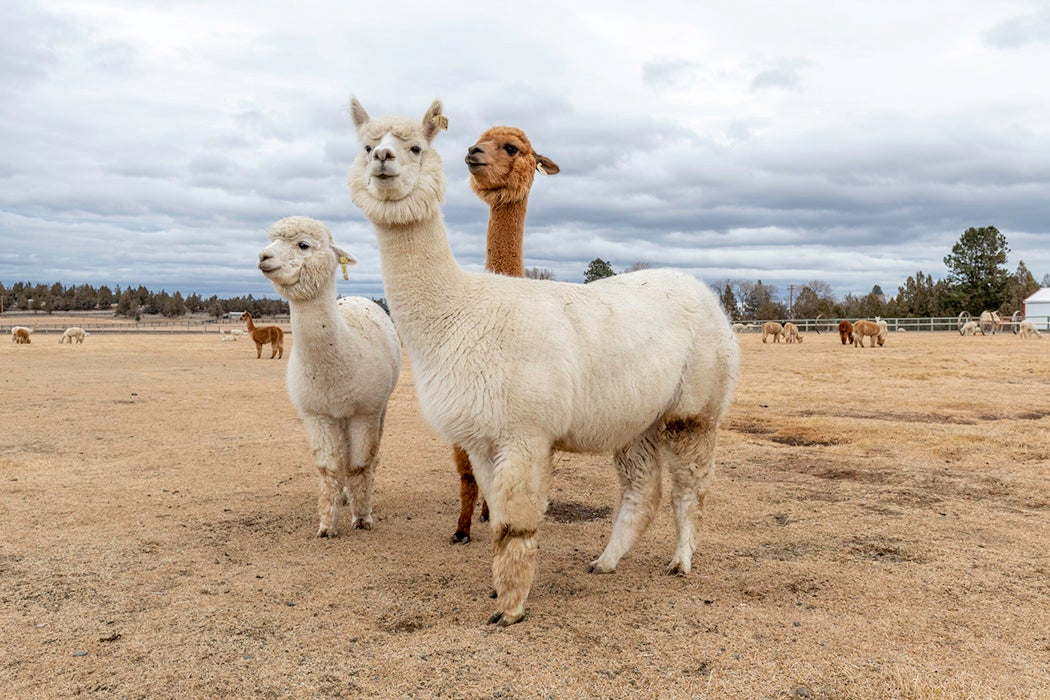We’re apparently in the midst of an alpaca boom. These cute (and odd-looking) furry creatures have increased in popularity in the United States, and agricultural economists Tina Saitone and Richard Sexton see in the alpaca all the marks of a speculative bubble.
Agricultural speculation bubbles, they explain, can be seen as far back as Dutch tulipmania. In the US, there have been passing crazes for animals from Merino sheep to Shetland ponies. Some of these rushes seem vaguely amusing (who would have thought a Shetland pony would make a person rich?) but, as they note, “Bubbles exact a real human toll in terms of lost nest eggs and disrupted or destroyed lives”.
The alpaca fad seems to have followed the model of earlier booms, with the added benefit of television advertising. Saitone and Sexton explain that the first alpacas arrived in the US in 1984, imported from South America.
“Touted in advertisements on national television as an alternative to the corporate lifestyle for average Americans, the US alpaca herd [grew] substantially over…twenty years with the stock of registered animals exceeding 86,000 at the start of 2006,” they write. This growth didn’t come cheaply. Alpacas in the US are expensive, some costing more than $25,000—making even a small herd a large investment.
A major factor in this price is agricultural laws. Similar animals are available in Peru for hundreds (rather than thousands) of dollars, yet import restrictions (due to foot-and-mouth disease) mean alpaca buyers in the US can’t practice the price arbitrage of buying cheaper Peruvian alpaca. As Saitone and Sexton describe, this artificial price inflation on the US market makes it even less likely for alpacas to be profitable.
“Apart from a small market…as pets or as rural ‘lawn mowers,’ fiber and progeny are the only marketable products produced by alpacas,” they write.
And this fiber doesn’t go for high prices, particularly from small producers. Because while alpacas cannot be imported from Peru, their fiber can be, at lower prices than US supply. If you knit, you may have purchased alpaca yarn. It came from alpacas in South America.
Part of what makes the alpaca situation consistent with other historical bubbles is that it’s attracted newcomers to agriculture.
“Small-scale investors predominate,” note the authors. In the US,
alpaca ranches are primarily small-scale operations, whose owner-investors may lack the expertise and resources to conduct independent investment analysis. Alpaca investors often come to agriculture from other careers—behavior that is encouraged in the advertisements.
Nor is the alpaca craze limited to the US. In the United Kingdom, the alpaca population has grown to around 35,000 (from less than 1,000 in the 1990s), according to a team of epidemiologists led by K. Halsby of the UK’s National Infections Service. These numbers bring their own problems. As non-native species (and relatively new arrivals in Europe), alpacas—and their llama cousins—are a new avenue for the spread of zoonotic diseases.
Though alpaca and llama are officially considered livestock, Halsby et al. note that they’re frequently considered and treated as pets. They’re “sometimes reported to be hardy and relatively disease-resistant,” but Halsby et al. report that this isn’t true. In the UK, they actually function as “good sentinels for disease since they are susceptible to some of the diseases seen in cattle and sheep.”
Perhaps even worse, once contracted, many of those diseases make the leap from the farmyard to the farmhouse.
Weekly Newsletter
“Of the potential zoonoses which have been identified in SACs [South American camelids] in England and Wales,” write Halsby et al., “tuberculosis (TB), cryptosporidiosis and sarcoptic mange are known to have been transmitted to humans.”
Again, the fact that the animals are often bought by inexperienced farmers compounds the problem. Their crossover status between pet and farm animal makes alpaca potentially more of a risk in terms of spreading diseases to humans.
Despite this, alpaca still seem to be popular: they’re fluffy and quirky. This craze represents a new turn in agricultural globalization and the not-so-new fetishization of exotic animals. How the economic trend will turn depends on whether they can be seen as just expensive fuzzy pets rather than an investment opportunity.
Teaching Tips
- “The Alpaca, Llama and Vicuna in California,” Scientific American (1863)
- A Memoir Addressed to Proprietors of Mountain and Other Waste Lands, and Agriculturists of the United Kingdom, on the Naturalization of the Alpaca (1841)
- The Alpaca; Its Introduction into Australia and the Probabilities of Its Acclimatisation There (1861)
Support JSTOR Daily! Join our membership program on Patreon today.







